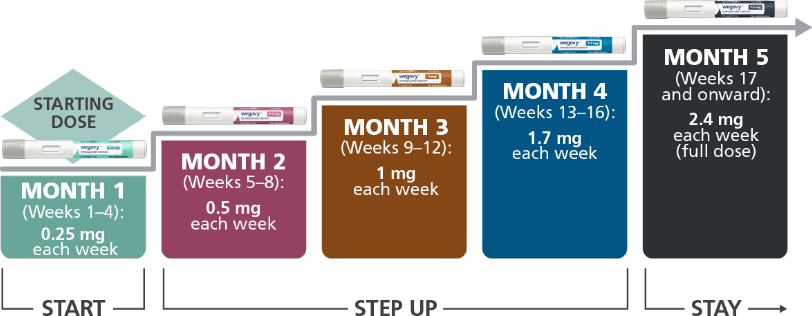Sermorelin/Ipamorelin
Sermorelin/
Ipamorelin
Sermorelin/Ipamorelin is a synthetic form of a hormone naturally produced in the body called Growth Hormone Releasing Hormone (GHRH). It is typically used to stimulate the production of growth hormone (GH) in the body, which can help to promote weight loss. It works by activating receptors in the pituitary gland to produce more GH, which can help to increase metabolic rate, reduce fat stores, and promote lean muscle mass. By increasing GH levels, Sermorelin/Ipamorelin can also help improve energy levels and reduce fatigue.
Sermorelin/Ipamorelin has also been shown to help improve overall health and well-being. By increasing GH levels, it can help to improve cognitive function, immune system functioning, and mood. It can also help to improve sleep quality and reduce the risk of developing certain diseases and conditions. Additionally, it can help to improve skin health and reduce the signs of aging.
Overall, Sermorelin/Ipamorelin can be an effective tool in promoting weight loss by increasing GH levels. It can also help to improve overall health and well-being while reducing the risk of developing certain diseases and conditions.
Dosing Schedule

How to administer a subcutaneous injection
Remove the cap from the needle.
Hold the syringe like a pencil close to the site.
Keep your fingers off the plunger.
Slightly pinch a fold of skin at the spot you chose

Pinch it between the fingers and thumb of one hand.
Place the syringe at a 90-degree angle to the shot site.

The needle should stand straight up from the skin.
Quickly push the needle all the way into the pinched-up fold of skin.

Push the plunger of the syringe all the way in.

This allows the medicine to go into the fatty tissue. Be sure to hold the skin fold as you give the shot.
This will help make sure that you don’t inject the medicine into muscle.
Take the needle out at the same angle that you inserted it.
Let go of the skin fold.
If you bleed a little, apply pressure over the shot area.
You can use your finger, a cotton ball, or a piece of gauze. To help avoid bruising, don’t rub the area.
Dispose of the needle safely.
Eating Protocol
Blueberry and Spinach Collagen Smoothie
1 tbs. Chia(2) ¼ c. water
1 tbs. Coconut Oil
1 tbs. Almond Butter
1 tbs. Coconut Flakes
1 tsp. Grated Ginger
1 c. Spinach (Raw or Frozen)
1 c. Blueberries (Raw or Frozen)
2 Scoops Flavorless Collagen
¼ tsp. Cinnamon
Dash of salt
4-6 ice cubes
19 g Net Carbs
19 g Protein
32 g Fat
Spinach and Tomato Scrambled Eggs
8 eggs, 2 cups fresh spinach leaves, ½ cup fresh tomatoes, chopped, 1 tablespoon butter, Salt and pepper to taste, 2 cups raspberries (optional)
Crack the eggs into a bowl, add a pinch of salt and pepper, and whisk until blended. Melt butter in a large saucepan over low heat. Pour egg mixture into saucepan and cook until a thin layer of cooked egg appears around the edge of the saucepan. Fold the eggs gently. Continue to cook, pushing and folding eggs around the pan occasionally. Halfway through cooking, add the spinach and tomatoes. Continue pushing and folding eggs until eggs are barely set. They should look a bit runny on top. Serve the scrambled eggs with a small bowl of fresh raspberries
Greek Yogurt Bowl or Smoothie
¾ plain Greek Yogurt, 3 tablespoons chia seeds, ¼ cup almonds (almond butter for Smoothie), ½ cup strawberries or blueberries
Shrimp Scampi with Zucchini Noodles
12 ounces raw shrimp
2 tablespoons olive oil
2 tablespoons butter
4 cloves of garlic, minced
Pinch of red pepper flakes (optional)
Salt and pepper to taste
2 cups zucchini, spiralized
Juice of one lemon
¼ cup fresh flat-leaf parsley, chopped
Heat a pan over medium. Add shrimp and 6 tablespoons of water. Sauté until pink. Add the olive oil, butter, garlic, and red pepper flakes and stir to combine. Season with salt and pepper and remove from heat. Add the zucchini spirals to the pan and cook for a few minutes until desired texture is reached. Add the shrimp back into the pan, along with the lemon juice and parsley, and stir to combine. Plate the shrimp scampi and zucchini noodles. Enjoy!
Stuffed Portobello Mushrooms
¼ cup olive oil
8 ounces 90% lean ground beef
4 cloves of garlic, minced
1 cup cauliflower rice
Salt and pepper to taste
½ teaspoon dried oregano
½ teaspoon dried thyme
½ teaspoon dried basil
½ teaspoon dried rosemary
8 ounces parmesan, shredded
2 cups fresh spinach
4 large portabello mushrooms, stem removed
Preparation
Preheat oven to 400℉.
Bake the mushrooms on a sheet pan for 10 minutes. Remove from oven and use a paper towel to absorb any excess water from the mushrooms.
Set the mushrooms aside
Heat the olive oil in a pan over medium heat.
Add the ground beef to the pan, season with salt and pepper, and cook for 4-6 minutes. Break up the ground beef into smaller pieces while cooking.
Add the garlic and cauliflower rice to the pan and cook for 4-6 minutes.
Add the oregano, thyme, basil, and rosemary and stir to combine.
Add the spinach and cook until wilted.
Stuff the mushroom caps with the ground beef mixture, top with parmesan cheese, and bake in the oven for 10 minutes, until the stuffing is heated through and the cheese is golden brown.
Plate the mushrooms and enjoy!
Fresh Lemon And Thyme Chicken And String Beans.
Macros: 7g net carbs, 4g Fiber, 38g fat, 40g protein
Ingredients
½ cup slivered almonds
2 medium yellow onions, sliced
1 pound chicken breasts, cut in ½” pieces
½ cup ghee, divided
Salt and pepper to taste
2 cups fresh string beans, trimmed
¼ cup water
1 tablespoon fresh thyme
1 lemon, quartered
Preparation
Heat a saucepan over medium heat.
Add sliced almonds. Cook until the almonds start to brown, stirring constantly. Remove from pan and set aside.
Add ½ of the ghee to pan. Once melted, add the sliced onions and sauté until golden brown. Remove from pan and set aside.
Season chicken with salt and pepper, add to pan, and sauté for 4-5 minutes (until reaches 165 degrees). Remove chicken from pan and set aside.
Add the remaining ghee to the pan, Once melted, add the string beans and the water to the pan. Cover and steam fry the string beans for 3-4 minutes.
Plate onions and string beans.
Place chicken over onions, and garnish with fresh thyme.
Garnish the string beans with the toasted almonds.
Serve with a piece of lemon on the side.
Common Side Effects on Semaglutide
(These side effects should be expected to some degree)
Tips for managing nausea
Eat bland, low-fat foods, like crackers, toast, and rice

Eat foods that contain water, like soups and gelatin Avoid lying down after you eat

Go outdoors for fresh air

Eat more slowly
Semaglutide can cause serious side effects, including:
Before using semaglutide, let your healthcare provider know of any other medical conditions. These include:
Let your healthcare provider know about the medications you take. These medications include over the counter, prescriptions, vitamins, and herbal supplements. Semaglutide can affect how some medicines work, and some medicines may cause problems with Semaglutide. Let your healthcare provider know about other medications you use to treat diabetes, including insulin or sulfonylureas. Semaglutide decreases stomach emptying and this can cause problems with medicines that need to pass through the stomach quickly.
Semaglutide can cause side effects, including:
While you are taking semaglutide, it is very important that you follow up with your medical provider as instructed. You will be required to have a follow up visit with the medical provider monthly to continue being prescribed semaglutide. Your next follow up visit should be scheduled at check out after every weight loss visit. You can cancel and/or reschedule your follow up appointments, however the office requires 24-hour notice in order for you to not be charged a “no-show” fee.
We Are Here to Help
Ready To Schedule Your Beauty Treatment?
Ready To Schedule Your
Beauty Treatment?
We offer free consultations.
Ready To Schedule Your Beauty Treatment?
Ready To Schedule Your
Beauty Treatment?
We offer free consultations.